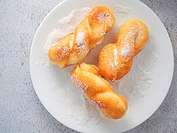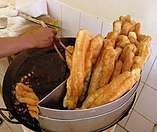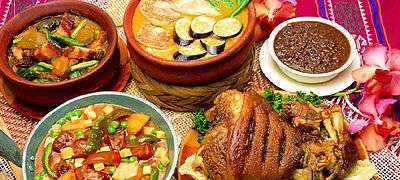Youtiao
Youtiao, is a long golden-brown deep-fried strip of dough commonly eaten in China and (by a variety of other names) in other East and Southeast Asian cuisines. Conventionally, youtiao are lightly salted and made so they can be torn lengthwise in two.[1] Youtiao are normally eaten at breakfast[2][3] as an accompaniment for rice congee, soy milk or regular milk blended with sugar. Youtiao may be known elsewhere as Chinese cruller,[4] Chinese fried churro, Chinese oil stick,[5] Chinese doughnut, Chinese breadstick, and fried breadstick,
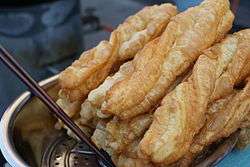 Pieces of youtiao | |
| Alternative names | Chinese cruller |
|---|---|
| Type | Doughnut |
| Course | Breakfast |
| Place of origin | China |
| Region or state | East Asia and Southeast Asia |
| Associated national cuisine | China, Cambodia, Singapore, Malaysia, Indonesia, Philippines, Brunei, Myanmar, Thailand, Taiwan, and Vietnam |
| Serving temperature | Fried |
| Main ingredients | Dough |
| Youtiao | |||||||||||||||||||||||
|---|---|---|---|---|---|---|---|---|---|---|---|---|---|---|---|---|---|---|---|---|---|---|---|
| Chinese name | |||||||||||||||||||||||
| Traditional Chinese | 油條 | ||||||||||||||||||||||
| Simplified Chinese | 油条 | ||||||||||||||||||||||
| Literal meaning | oil strip | ||||||||||||||||||||||
| |||||||||||||||||||||||
| Yu Char Kway | |||||||||||||||||||||||
| Traditional Chinese | 油炸粿/餜/鬼 | ||||||||||||||||||||||
| Simplified Chinese | 油炸粿/馃/鬼 | ||||||||||||||||||||||
| Literal meaning | oil-fried pastry (or devil) | ||||||||||||||||||||||
| |||||||||||||||||||||||
| Guozi | |||||||||||||||||||||||
| Traditional Chinese | 餜子 | ||||||||||||||||||||||
| Simplified Chinese | 馃子 | ||||||||||||||||||||||
| Literal meaning | pastry | ||||||||||||||||||||||
| |||||||||||||||||||||||
| Burmese name | |||||||||||||||||||||||
| Burmese | အီကြာကွေး | ||||||||||||||||||||||
| Thai name | |||||||||||||||||||||||
| Thai | ปาท่องโก๋ | ||||||||||||||||||||||
| RTGS | pathongko | ||||||||||||||||||||||
| Malay name | |||||||||||||||||||||||
| Malay | Cakoi | ||||||||||||||||||||||
| Indonesian name | |||||||||||||||||||||||
| Indonesian | cakwe | ||||||||||||||||||||||
| Filipino name | |||||||||||||||||||||||
| Tagalog | bicho-bicho/shakoy | ||||||||||||||||||||||
In Malaysia, Indonesia and Singapore, they are called You Char Kway, Cakwe, Cakoi, Kueh, Kuay. In Philippines, it is called Bicho/Bicho-Bicho or Shakoy.
Culinary applications and variants
At breakfast, youtiao can be stuffed inside shāobǐng (simplified Chinese: 烧饼; traditional Chinese: 燒餅; lit.: 'roasted flatbread') to make a sandwich known as shāobǐng yóutiáo (simplified Chinese: 烧饼油条; traditional Chinese: 燒餅油條). Youtiao wrapped in a rice noodle roll is known as zháliǎng. In Yunnan, a roasted riceflour pancake usually wrapped around a youtiao is known as shaoerkuai (simplified Chinese: 烧饵块; traditional Chinese: 燒餌塊).[6] Yet another name for a sandwich variant is jianbingguǒzi (simplified Chinese: 煎饼果子; traditional Chinese: 煎餅果子; lit.: 'youtiao and fried bread').
Youtiao is occasionally dipped into various liquids, for example the soup xidoufen, soymilk (sweet or salty), and soy sauce.
Youtiao is also an important ingredient of the food Cífàn tuán in Shanghai cuisine.
Tánggāo (Chinese: 糖糕), or "sugar cake", is a sweet, fried food item similar in appearance to youtiao but shorter in length.
In Cambodia, it's called chhakhvay (ឆាខ្វៃ) and often eaten with rice congee (porridge) for breakfast.
In Thailand, youtiao or pathongko (ปาท่องโก๋) in Thai are eaten for breakfast with soymilk or porridge.
Names
China
Although generally known as yóutiáo in Standard Mandarin throughout China, the dish is also known as guǒzi (餜子) in northern China. In Min Nan-speaking areas, such as Taiwan, it is known as iû-chiā-kóe (油炸粿),[7] where kóe (粿/餜) means cake or pastry, hence "oil-fried cake/pastry". In Cantonese-speaking areas this is rendered as yàuhjagwái (油炸鬼), where gwái literally means "devil" or "ghost".[lower-alpha 1]
Folk etymology
The Cantonese name yàuhjagwái literally means "oil-fried devil" and, according to folklore,[8] is an act of protest against Song Dynasty official Qin Hui, who is said to have orchestrated the plot to frame the general Yue Fei, an icon of patriotism in Chinese culture. It is said that the food, originally in the shape of two human-shaped pieces of dough but later evolved into two pieces joined in the middle, represents Qin Hui and his wife, both having a hand in collaborating with the enemy to bring about the great general's demise.[9] Thus the youtiao is deep fried and eaten as if done to the traitorous couple. In keeping with the legend, youtiao are often made as two foot-long rolls of dough joined along the middle, with one roll representing the husband and the other the wife.[10] The Cantonese name may derive from Guangzhou being the last resistance front before the Song dynasty collapsed.
Cambodia
In Cambodia, it is called Cha Kway. Cambodians usually dip it in rice congee (porridge) or coffee.
In Australia it is sometimes called chopstick cake by some Cambodian Chinese immigrants because of its resemblance to a pair of chopsticks.
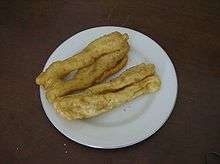
Indonesia
In Indonesia, the fried dough is known as cakwe (pronounced [tʃakwe]). It is commonly chopped or thinly sliced and then eaten for breakfast with bubur ayam (chicken porridge) or eaten as snacks with dipping of local version of chilli vinaigrette or peanut / satay sauce.
In Semarang, cakwe is usually sold as a street snack at kaki lima, at the same stalls that sell bolang-baling and untir-untir (Javanese names for fried donuts or ham chim peng and mahua, respectively). With savoury cakwe and sweet bolang-baling being soft and fluffy and untir-untir being crispy, they make a good snack mix.
Laos
In Laos, youtiao is generally called kao nom kou or patongko (cf. Thai patongko) or "chao quay", and is commonly eaten with coffee at breakfast in place of a baguette (khao jee falang).[11] It is also eaten as an accompaniment to "khao piek sen" (chicken noodle soup) or "jok" (congee).
Malaysia and Singapore
In Malaysia and Singapore, it is known in English as you char kway, you char kuey, or u char kway, which are transliterations of its local Hokkien (Minnan) name (油炸粿 iû-chiā-kóe). It is rendered in Malay as cakoi, an alteration of the Minnan term, "char kuey". The Malay version comes with various fillings, which are either sweet, such as red bean paste or savoury, such as sardines fried in tomato sauce. The plain version is usually eaten with coconut and egg jam kaya. Cakoi is usually sold in morning street markets or "pasar malam" night markets.
It is also normally served with Bak kut teh (肉骨茶), porridge or rice congee, sliced thinly to be dipped into the broth/congee and eaten. It is also commonly eaten with coffee or soy milk for breakfast.
Myanmar
The youtiao is also a popular breakfast food in Myanmar (Burma) where it is called e kya kway (အီကြာကွေး [ì tʒà ku̯éː]) . It is usually eaten with steamed yellow beans (with salt and oil). It is also usually dipped into coffee or tea. E kya kway is also eaten with rice porridge, or cut into small rings and used as a condiment for mohinga. Tea culture is very prevalent in Myanmar, and every shop will serve e kya kway for breakfast.
Some shops stuff meat into the youtiao and deep fry it over again. It is called e kya kway asar thoot – stuffed e kya kway.
Philippines
In the Philippines, it is either known as Bicho / Bicho-Bicho or Shakoy / Siyakoy / Pinisi / lubid-lubid. They are usually deep-fried, in the case of Bicho-Bicho, or deep-fried and twisted as twisted doughnuts, in the case of Shakoy. Dry, smaller and crunchy versions are called pilipit.
Thailand
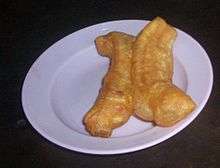
In Thailand, youtiao is generally called pathongko (Thai: ปาท่องโก๋, pronounced [paːtʰɔ̂ŋkǒː]) due to a confusion with a different kind of dessert. Pathongko is a loanword adapted from either Teochew Minnan beh teung guai (白糖粿; Mandarin: bái tángguǒ) or Cantonese of baahktònggòu (白糖糕; Mandarin: bái tánggāo). However, both possible original names are different desserts, not to be confused with the real white sugar sponge cake (白糖糕). It was previously sold together with youtiao by street vendors who normally walked around and shouted both names out loud. However, Thai customers often mistakenly thought that the more popular youtiao was "pathongko". Eventually, the real pathongko disappeared from the market because of its unpopularity. Ironically, the disappearance of real "pathongko" leaves youtiao being called under the former's name, but the latter's real name is generally unknown amongst the Thais. But the original white sugar sponge cake can still be easily found in Trang Province in Southern Thailand under its original name while youtiao is still called "chakoi" or "chiakoi" by some Southerners.
In Thailand, pathongko is also dipped into condensed milk or, in the South, eaten with kaya.
Vietnam

In Vietnamese cuisine, it is known by a name that is a mix of Sino-Vietnamese and native Vietnamese to achieve a pronunciation similar to the Cantonese name, as dầu cháo quẩy, giò cháo quẩy or simply quẩy. 油 ("Dầu/giò") 鬼 ("quỷ/quẩy") coming from the approximate Chinese name. In Vietnam, giò cháo quẩy is eaten typically with congee, pho in Hanoi and sometimes with wonton noodle (mi hoanh thanh).
See also
- Fried dough foods
- List of Chinese dishes
- List of doughnut varieties
- List of deep fried foods
- List of snack foods
- List of street foods
- Zhaliang
- Ci fan tuan
Similar Chinese foods
Other similar foods
- Boortsog from Mongolia and Central Asia
- Churro from Iberia
- Cruller
- Beignet from New Orleans (USA)
- Tenkasu from Japan
Notes
- Similarly, the dish known as chhá-koé-tiâu (炒粿條) in Minnan, kóe-tiâu being the Minnan name for flat rice noodles (literally "(rice) cake strips"), is on Cantonese menus rendered as 炒貴刁 (ja gwaidìu) where the characters 貴刁 (gwaidìu, literally expensive (Surname)) are equally meaningless. See Char koay teow: Etymology for more information.
References
- Youtiao (Chinese Oil Stick)-Chinese Cruller – China Sichuan Food
- Youtiao Chinese Deep Fried Donuts) Recipe - Food.com
- Chinese Doughnut Recipe (Crisp Fried Fritters/Breadstick) | 油條 Yóutiáo - Angel Wong's Kitchen
- "Chinese Breakfast" at About.com. Accessed 1 May 2008.
- Healthier 'youtiao'? Chengdu vendor finds breakthrough recipe | South China Morning Post
- "Chinese Fried Dough Stick". Retrieved 22 April 2020.
- 許極燉. 《常用漢字台語詞典》. 台北市: 自立晚報社文化出版部, 1992. (A Taiwanese dictionary with frequently used Chinese characters. Taipei: Independence Evening Post, 1992.) (in Chinese)
- Yew Char Kway the Easy Way by denise fletcher on July 7, 2011
- Youtiao (Chinese Crullers) - Ang Sarap
- West Lake, a Collection of Folktales (ISBN 9620400542) page 181.
- "Laos: Food and Drink." Archived June 16, 2008, at the Wayback Machine at CPAMedia. Accessed 30 May 2008.
